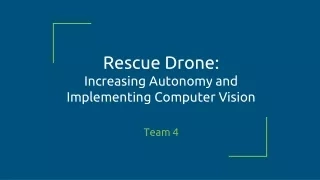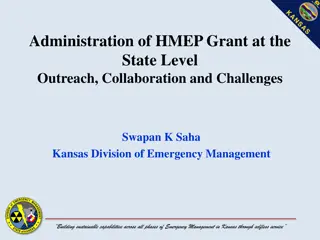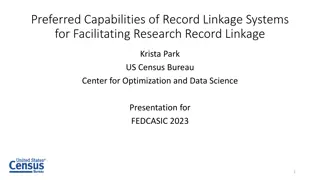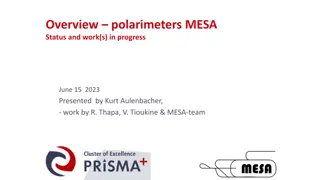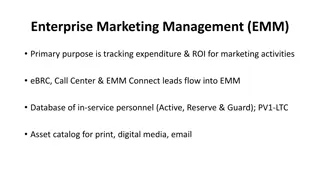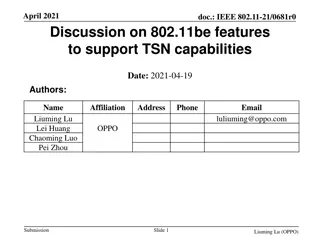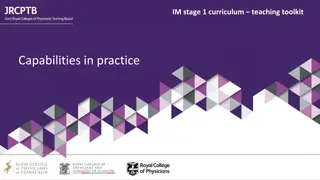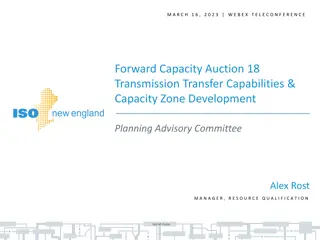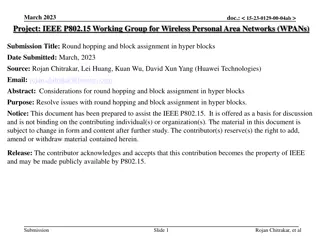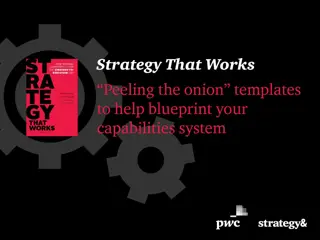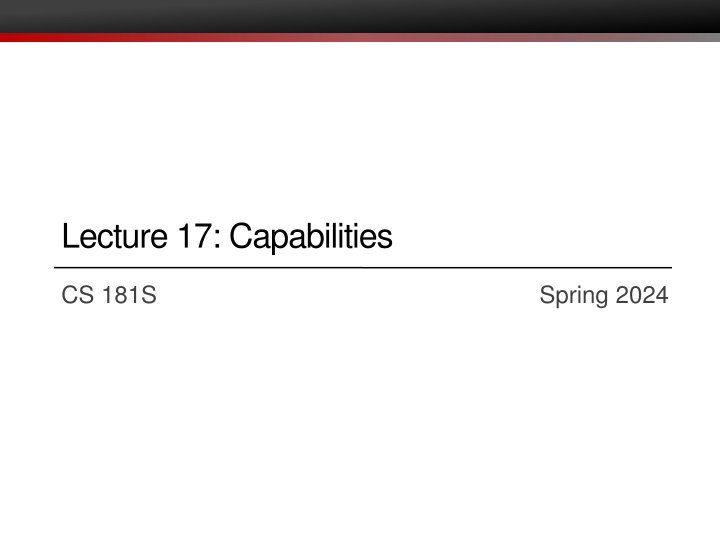
Access Control Policies and Protection Domains in Computer Systems
Explores the concepts of access control policies, protection domains, and role-based access control in computer systems. Learn about mechanisms that bind principals to actions, discretionary and mandatory access control, and the implementation of protection domains to manage privileges effectively.
Download Presentation

Please find below an Image/Link to download the presentation.
The content on the website is provided AS IS for your information and personal use only. It may not be sold, licensed, or shared on other websites without obtaining consent from the author. If you encounter any issues during the download, it is possible that the publisher has removed the file from their server.
You are allowed to download the files provided on this website for personal or commercial use, subject to the condition that they are used lawfully. All files are the property of their respective owners.
The content on the website is provided AS IS for your information and personal use only. It may not be sold, licensed, or shared on other websites without obtaining consent from the author.
E N D
Presentation Transcript
Lecture 17: Capabilities CS 181S Spring 2024
Where we were Authentication: mechanisms that bind principals to actions Authorization: mechanisms that govern whether actions are permitted Discretionary Access Control Mandatory Access Control
Access Control Policy An access control policy specifies which of the operations associated with any given object each principal is authorized to perform Expressed as a relation ??? : Objects ???? dac.tex dac.pptx r,w r r ebirrell faculty student r,w r Capability Lists principals Access Control Lists
Protection Domains Motivation: users are too coarse-grained to define privileges Protection Domains: Each thread of control is associated with a protection domain Each protection domain is associated with a different set of privileges We allow transitions from one protection domain to another as execution of the thread proceeds.
Protection Domains Typical implementation: certain system calls cause protection-domain transitions. System calls for invoking a program or changing from user mode to supervisor mode are obvious candidates. Some operating systems provide an explicit domain- change system call instead the application programmer or a compiler s code generator is then required to decide when to invoke this domain-change system call We use the term attenuation of privilege for a transition into a protection domain that eliminates privileges. We use the term amplification of privilege for a transition into a protection domain that adds privileges.
Protection Domains Objects Objects ebirrell @sh x dac.tex dac.tex dac.pptx dac.pptx ebirrell @edit x ebirrell@ powerpoint x ebirrell@sh ebirrell@edit ebirrell@powerpoint drdave@sh drdave@edit drdave@powerpoint studenta@sh studenta@edit studenta@powerpoint studenta@powerpoint ebirrell@sh ebirrell@edit ebirrell@powerpoint drdave@sh drdave@edit drdave@powerpoint studenta@sh studenta@edit r,w r,w r,w r,w principals principals r r r r r r
Role-Based Access Control Particularly in corporate and institutional settings, users might be granted privileges by virtue of membership in a group. E.g., students who enroll in a class should be given access to that semester s class notes and assignments simply due to their new role Without groups, implementing role-based access control is error prone Adding or deleting a member might require updating many access control lists. That can be error-prone. Revocation is subtle. Should permission be removed with principal is removed from a group?
Exercise 3: RBAC What roles might you want to include in a course management system?
Confused Deputy Server: operation( f : file ) buffer := FileSys.Read( f ) results := F( buffer ) diff:= calcDiff( results ) FileSys.Write( f , results ) FileSys.Write( log.txt, diff )
Cross-Site Request Forgery (CSRF) Server Victim 1 4 2 User Victim Attack Server
Access Control Policy An access control policy specifies which of the operations associated with any given object each principal is authorized to perform Expressed as a relation ??? : Objects ???? dac.tex dac.pptx r,w r r ebirrell faculty student r,w r Capability Lists principals Access Control Lists
Capability Lists The capability list for a principal ? is a list ?1,?????1 , ?2,?????2 , , ??,?????? e.g., dac.tex, {r,w} dac.pptx, {r,w} Capabilities carry privileges. 1) Authorization: Performing operation ?? on object ?? requires a principal ? to hold a capability ??= ??,?????? such that ?? ?????? 2) Unforgeability: Capabilities cannot be counterfeited or corrupted. Note: Capabilities are (typically) transferable
Capabilities Advantages: Natural approach for user-defined objects Eliminates confused deputy problems Disadvantages: Review of permissions? Revocation? Delegation? Privacy?
Exercise 1: Capabilities Consider the following proposal: capabilities will be represented using a pair ???? ??? ,????? , where ???? ??? is a random 128-bit string and ????? is the set of privileges conferred by the capability. The function ????, if it exists at all, is kept secret. What functionality expected for capabilities does this alternative support and where (if at all) does it fall short?
Example: OAuth2 Industry standard authorization protocol Used for single sign-on by major IDPs Facebook, Google A bearer token contains a unique identifier
Authenticity: Tagged Memory 1 obj 1 type p1p2 pN Example: IBM System 38 tag = 0: normal memory tag = 1: this word + next are a capability In user mode, cannot modify tag bit or modify word with tag = 1 Exception: can copy capabilities pass capabilities in function calls
Authenticity: Protected Address Space General idea: store capabilities in region of memory we know how to protect Option 1: protected kernel memory Option 2: protected memory segment Note: OS must be trusted Store list of capabilities in process control block Capabilities referenced by index into c-list
Example: File Descriptor Table In Unix etc, a file descriptor is a handle used to reference files and I/O resources File descriptors have modes (read, write) and are stored in per-process file descriptor table File descriptors can be passed between processes using sendmsg()
Cryptographically-protected capabilities Object owner creates capabilities using a digital signature scheme Capabilities are triples ? = ?,?????,Sig(?,?????;??) Authorization: P is permitted to perform op on O if P produces a capability for O with ?? ????? and a valid signature Unforgeability: digital signatures are unforgeable to adversaries who don't know private key ?? Note: assumes PKI
Restricted Delegation ?0= ?,?????0,??1,?0 where ?0= Sig ?,?????0,??1;??0 ?1= ?,?????1,??2,(?????0,??1,?0),?1 Where ?1= Sig ?,?????1,??2,(??????,??1,?0);?1 To Authorize ?? with ?0: 1. Verify ?0 is a valid signature of (?,?????0,??1) 2. Check that ?? ?????0 To Authorize ?? with ?1: 1. Verify ?0 is a valid signature of (?,?????0,??1) 2. Verify ?1 is a valid signature of (?,?????1,??2,(??????,??1,?0)) 3. Check that ?????1 ?????0 4. Check that ?? ?????1
Exercise 2: Restricted Delegation Assume you have a credential ?1= ???.????,{?,?},??2,({?,?,?},??1,?0),?1 Generate a credential ?2 that would authorized the holder to read (but not write) dac.pptx ?2= ???.????,{?},??3, ?,?,? ,??1,?0, 1. ?,? ,??2,?1,?2 Define the sequence of steps that should be taken to authorize ?? with ?2 2. Verify ?0 is a valid signature of (???.????, ?,?,? ,??1) Verify ?1 is a valid signature of (???.????,{?,?},??2, Verify ?2 is a valid signature of (???.????,{?},??3, ?,?,? ,??1,?0, Check that ?????1 ?????0 Check that ?????2 ?????1 Check that ?? ?????2 1. 2. 3. ?,?,? ,??1,?0 ) ?,? ,??2,?1 ) 4. 5. 6.
Revocation Revocation Tags Capabilities are tuples ? = ?,?????,??c,Sig(?,?????,???;?) Access to object O is guarded by a reference monitor; monitor maintains a list of revoked tags ??c Capability Chains Objects can be other capabilities! ? is authorized to perform ?? on ? if ? holds a capability ?? and ?? ??????holds for every capability ?? in the chain from ?? to ?1
Keys as capabilities Encrypt object Decryption method functions as reference monitor: Authorization: correct key will decrypt object -> allow access Unforgeability: incorrect key will not decrypt Note: no notion of separate privileges
Example: Mac keychains OSX/iOS password manager uses password-based encryption (AES-256) to store username/password credentials supports multiple keychains

